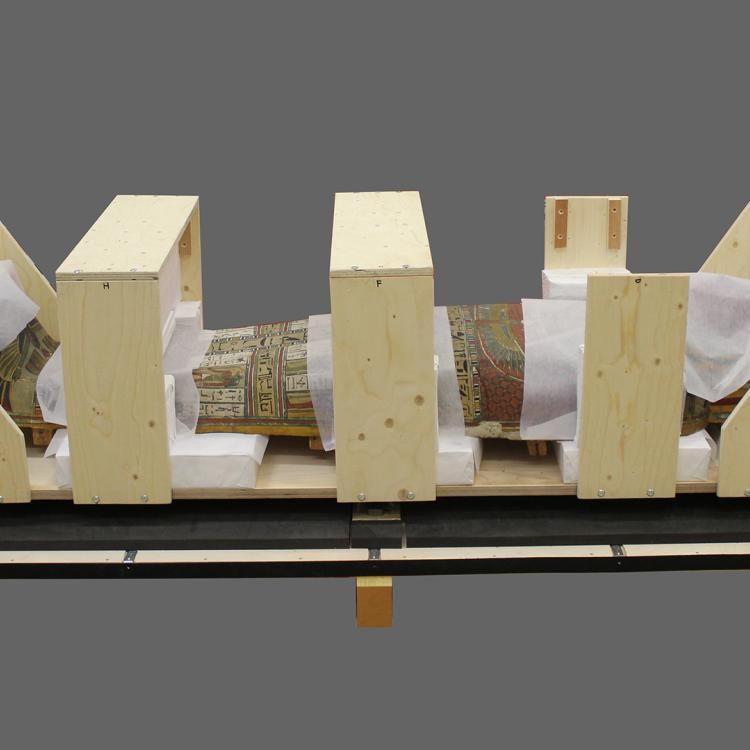Key project information
Duration
2019 – 2024
Contact
Partner
Institute of Sound and Vibration Research (ISVR), University of Southampton
Dr Kerstin Kracht, Freelance engineer for vibration technology and continuum dynamics, Germany
What is the impact of shock and vibration on museum objects during loan transport?
Visitors in galleries, construction work and transportation in lorries or planes are all common sources of vibration that could have an effect on museum objects. However, little is known about the damage that this vibration causes.
This project aims to increase understanding of the impact of vibration on museum objects during transportation. It brings together a multi-disciplinary team of conservators, collection managers, mechanical engineers and imaging specialists to explore how the risk to objects during transit can be reduced.
There are two strands to this project:
- Quantifying the effects of vibration and shock on museum objects leading to a framework by which objects are judged fit to travel.
- Evaluation and improvement of packing crates for loan transport.
About the project
Vibration of museum objects can result in cracks and tears, detachment of paint and opening of joints among other things. However, little is known about which features of a vibration environment, such as frequency content, peak amplitude or duration, are most damaging to different types of objects.
The purpose of this project is to increase understanding of the risks that shock and vibration pose to the British Museum collection, in order to develop methods for moving fragile objects more safely. It will:
- Inform and improve the Museum’s guidance on handling, object movement and packing methodologies.
- Enable conservators and collection managers to assess the vulnerability of objects more accurately.
- Allow Museum staff to tailor transport packing and methods to improve the protection of objects.
- Support the Museum’s ambition to share its collection widely.
Working with engineer Kerstin Kracht, this project has focussed on developing packing crates with improved vibration isolation using wire-rope isolators. This research involved a number of approaches including digital modelling of object behaviour and crate performance, using finite element models.
Research exploring the fragility of museum objects and their susceptibility to the effects of vibration is supported by a Collaborative Doctoral Partnership studentship with the University of Southampton (funded by the Arts and Humanities Research Council). So far research has focussed on experimental and digital analyses to determine the vibration behaviour of objects.
Aims
This project aims to answer the following:
- How can the fragility of objects in the Museum collection be assessed more accurately?
- What kind of vibration is most damaging to particular collections?
- In which transport scenarios are collections most at risk and what vibration mitigation measures can be employed to prevent damage to objects?
- How successful are the vibration control measures currently used by the Museum and how can their effectiveness be further improved?
- Can effective vibration mitigation measures be achieved with sustainable materials and methods?
To answer the questions above, the project first needs to:
- Quantify the effects of vibration and shock on museum objects.
- Provide a scientifically informed framework by which objects are judged fit to travel.
- Investigate what advanced technologies could be used to protect objects from vibration and shock.
This research will be shared in journal articles, academic conferences, blogs and videos.
Conclusion
Since the project began in 2019, a series of studies evaluating the performance of standard British Museum packing crates and crates with additional shock and vibration mitigation were concluded. They demonstrated that standardised packing with enhanced vibration mitigation is achievable in a busy museum environment. This packing method can be applied to clusters of three dimensional objects that are similar in weight, geometry and fragility, and has led to the development of a crate calculator tool.
The outcomes of this research are now being applied at the Museum. For example, a vibration mitigation system using wire-rope isolators (a type of steel spring) was implemented in nine object transportation crates for the international touring exhibition Mummies of ancient Egypt: rediscovering six lives (2021).
Meet the team

Verena Kotonski
Principal Investigator
Department of Collection Care
British Museum

Kerstin Kracht
Co-Investigator
Freelance engineer for vibration technology & continuum dynamics

Tim Waters
Co-Investigator
ISVR, University of Southampton

Evan York
Co-Investigator
Department of Egypt and Sudan
British Museum

Carl Heron
Co-Investigator
Department of Scientific Research
British Museum

Thomas Hutchin
PhD student
ISVR, University of Southampton
British Museum
Project team
Outputs
Shock and vibration response of museum objects during transportation
JOURNAL ARTICLE
Thomas Hutchin; Timothy Waters; Verena Kotonski
Journal of Physics: Conference Series
Published in 2024
Protecting three-dimensional museum collections during transport: engineering and evaluation of transport crates featuring wire-rope isolators for improved vibration mitigation
JOURNAL ARTICLE
Verena Kotonski; Kerstin Kracht; Evan York; Caroline Barton
IIC Wellington Congress preprint
Published in 2022





